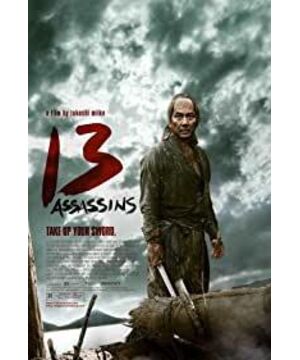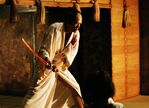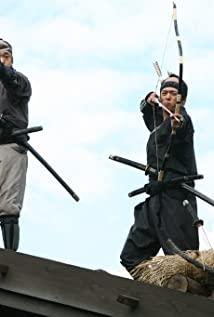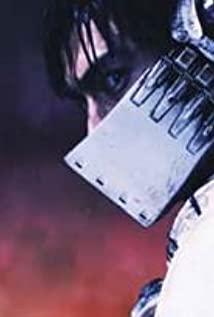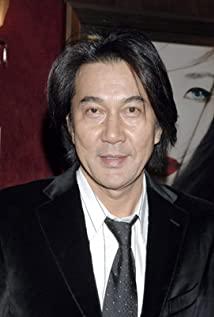This "overhead literature" is not easy to write. The sword halberd film itself is a genre that has been changing. From the 1920s to the 1980s, with technological progress and the evolution of social thoughts, the appearance has undergone great changes. What is certain is that even if Japanese movies have not been shocked, sword halberd movies will be quite different from the golden age. It is impossible to use new technologies such as wide-angle lens and pyrotechnic blasting. It sticks to the telephoto lens and the simple killing scene of "shoulders, stomachs and backs". . These are not in line with the development history and law of evolution of sword halberd films advancing with the times. But at least judging from certain trends before the "breathing" of sword halberd films in the 1980s, some things will definitely persist. For example, new technology will only make its art work more smoky, and will not become today's "rattan". For example, the theme of idol dramas like the "Ze Zhouping Series" must be more "under control", reflecting the trend of more democracy and pluralism in modern society.
Unfortunately, all of this can only be assumed, the so-called "sword and halberd tablets" that are now revived, the blood flowing in the body is no longer the pure blood of the old films. Today's Japanese costume action movies take three paths. The first is the Fujisawa series of "Pure Love + Xiaofan Disturbance + Four Seasons Beauty". Thanks to the original work, the plot is a bit chivalrous, but the artists and performances are pure idol dramas, with loose rhythm He won the essence of the new Japanese movies in line with the serial dramas. Looking for the roots, it was all bad because Mr. Yamada picked Takuya Kimura to finish his samurai trilogy, bringing the originally very textured series to the gutter. The second is that cult films such as "Izang" and "Red Shadow" are interesting period dramas. The production cost is not high, and it is basically a joking spirit to tradition, which cannot be said to be inherited. The third is the major special effects productions represented by "Asura Castle" and "The Robber Ishikawa Goemon". I think it actually inherits the tradition of special filming in the studio era and introduces ACG elements. Good-looking is good-looking. After all, it is not a family with the so-called sword halberd.
Talking about the sword halberd movie for a long time, what does it have to do with the new version of "Thirteen Assassins"?
Because "Thirteen Assassins" is a sword halberd...
Don't beat me. To be precise, I think "Thirteen Assassins" is the kind of sword halberd that "if the sword halberd piece is not dead, it should become today"! To put it simply, "Thirteen Assassins" is the descendant of the classics of the brilliant swords and halberds!
Why? Because the original adaptation of it is a classic sword halberd film... Hey, kidding! I mean, the classic script guarantees the purity of the smell. The plot of the original is very simple, it is the story of how a group of assassins desperately eradicate the cruel lord under the instruction of the old family. The story is narrated very compact and lively, without any muddles, the focus is on the last half-hour "ambush" paragraph, the desperate killing of both sides in Ochiaiju. The new version of the plot structure has basically not made any major adjustments, even the narrative sequence is exactly the same, but the final battle array has been expanded into one hour. I think this kind of adaptation is a kind of wise, but also a kind of self-confidence. Explain that wisdom, because the original drama is very delicate and chaotic is useless. If you don’t believe it, you can check out "Eleven Samurai" directed by Kudo and Shaw Brothers's version of the martial arts classic "Six Assassins", which are exactly the same. . Speaking of self-confidence, it was taken by Miike according to the original script, and it still gives people a new feeling. This is the ability. A Chinese director who has no skill will only find the pleasure of "art creation" in the spoiled classic dramas, such as the triumphant version of "Orphans of Zhao Family", such as the Jin Chen version of Sun Pang Douzhi.
So where is the niubility of Sanchi? Let's grow up and say the same thing.
First, the cult film is interesting.
The first shots of the new version and the original are Mamiya-sama's grievances. The difference is that in the first shot of the original, Lord Mamiya has already died outside the government office, while the new version focuses on the process of his death, indicating that the new version cannot be the same as the original in terms of displaying cruelty and violence. The assassin found leeches crawling on his body in the forest, which was not in the original version. For 1 hour, 26 minutes and 40 seconds, the swordsman slashed the man on fire, and used computer stunts to explain the wrong scene at about 1 hour and 4 minutes, which was quite visually impactful. The most prominent difference is that when Cooke Doi persuaded Shimada to take on the responsibility of assassination, the new version added a woman with her limbs cut off and her tongue cut off to accuse Matsudaira Sabei's brutality, and the full body naked and handicapped scene was extremely shocking. Li is a scene that only appeared in cult movies in the past, and of course, it is also Sanchi's masterpiece!
If the fun of Cult movies is exclusively for showing off pornography or sensory stimulation, it is not far from the second type of movies I mentioned above. This time, Miike is determined to restore the epic atmosphere of the sword halberd film, and he can be said to have restrained his own evil taste. All these scenes are designed to match the plot. In fact, I think the cruelty of the lord in the feudal era, if it were really photographed, it should have been like this, but the old-style sword and halberd were deliberately avoided. The display of these scenes in the new version provided a more reliable basis for Shimada Shinzaemon's determination to dedicate himself to the cause of assassination, and aroused empathy from the audience. The most wonderful thing is that the film adds a small prop here, and the final hand-to-hand combat (in the trailer) is opened with the "Extreme Killing" complaint written by "Ren Yu" full of blood and tears. The "dog blood" in the cult film turned into warm blood in an instant, directly filling the heart of the new era sword halberd film.
Second, changes in settings and images.
The battle between the two sides has changed from thirteen to fifty to thirteen to two hundred. Of course, this change is mainly to increase the intensity of the confrontation and sensory stimulation. The new version of the Ochiaijuku battle uses gunpowder. How can you kill without two hundred enemies? ? However, the film also explains that this is the tactics of the ghost head Hanbei. He disappeared from the main road knowing that there was an ambush ahead, and bought time to mobilize more than 100 samurai from the Akashi clan to escort him. It is quite reasonable, but from the geographical location From the point of view, Ochiai-juku is already close to Akashi Clan, and it is entirely possible.
The swordsman played by Akira Nakanishimura died inexplicably in the original version, while the swordsman played by Takeshi Nakaihara is a majestic and majestic swordsman in the new version, performing a good show that relies on the "sword formation" to kill the ring. This touches on a fundamental difference between the two editions. Basically, the original edition does not pay much attention to sensory stimulation. It emphasizes human fate and maintains an ironic attitude towards the rigid samurai principles. Therefore, the composition emphasizes the layered vertical and horizontal lines. The more intense the battle, the denser the lines. For this, please refer to my old article "The rules are the fate of the samurai" ( http://i.mtime.com/fjs/ blog/2258804/). The new version delegates the task of satirizing the samurai to the lines, and the composition of the picture is much more open, emphasizing the vitality and destructive ability of the characters, mainly serving the sensory stimulation. As for which is smart, this is hard to say. I think the new version is a bit more straightforward in expressing the theme, especially at the end, a little impatient to go straight to the theme. The old version is much more subtle, but today's viewers will probably not have the time to figure it out. It is a reasonable attempt for Miike to do so.
The new and the old version handles differently. From the section of Playboy Shinrokuro's decision to participate in the "gamble" of assassinating the tyrant, the old version used him to walk into the fence of the street, implying that he was thrown into the shackles of fate. In the new version, Kauki asked him: "When will you be back?" He replied: "Soon, but if I'm late, I'll be back on the Mid-Autumn Festival (Ghost Festival). Please light me a fire." Street torch Shining on him, the light and shadow floated like a ghost. The method is different, but the meaning is the same.
It is worth mentioning that Miike retains the foggy scene from Kudo Ei's first edition. The ringtones are melodious before the start of the decisive battle, and the poetic scene of the enemy riding on the fog makes people feel quite moved back in time.
Third, adjustments in lines, roles, and themes.
From memory, I think the new version of the lines has changed quite a bit. Although what I see now is only English subtitles, it is obvious that the highlights are repeated. Take some translations and attach them to the back.
I think the most brilliantly revised version of this edition is the lines of Matsudaira Sahei. A tyrant who was originally very facial is now plump and three-dimensional in the new version. When shooting the Mamiya family, he could say, "The samurai died for his lord, and his wife died for his husband. I am perfecting you!" Such words indicate that this guy is completely sane. Before dying, he said, "We are all going to die. I really want to thank you. The happiest day in my life." Xinbingwei asked him: "Hanzo died for you, how can you kick him in the head?" He said: " If I die, you can kick me too." It also shows that this man is a total freak.
The most exciting is the following paragraph, when the two sides hit the most intense, the dialogue between him and his subordinate Hanzo.
"Hanzo, is it like this in the age of war?"
"Perhaps."
"It's magnificent! Only death can be grateful for life. If I wasted my life, it would be a waste of life. Hanzo, I have a good idea!"
"Oh?"
"If one day I am in power, let's fight again. !" The
shuddering thoughts are really perverted and poetic and philosophical!
Another difference between the new version and the old version lies in the motivation of the characters. The original version is a battle between good and evil, one side is brutal and unkind, and the other side acts for the heavens, so it is necessary to fight, very simple logic. In the new version, it goes without saying that the perverted lord killed people for fun, and even deliberately lost face in order to find excuses to punish Hanzo. On the justice side, the motives of Shinzaemon and his assassins also gained new meaning. They wanted to live out the dignity of a samurai in a peaceful and prosperous age, and went to the battlefield in search of the meaning of life. This is a very postmodern idea of Zhang Pili, "The Hurt Locker". Fortunately, Sanchi didn't pay much attention to this point, so he kept abreast of the times.
Finally, the epic pattern. A sword halberd film, it came up to point out that this happened "100 years before the Hiroshima-Nagasaki atomic bombing", what kind of school is it? At the end of the film, it was stated that "Twenty-three years later, the Tokugawa shogunate was eliminated". What kind of school is it? The legend of the Edo period in the original version was abruptly incorporated into the depth of history (well, the technique is indeed a bit blunt). The samurai fight for life, after all, for others. Utilitarian is like Hanzo, and the duty of a samurai is to protect the lord regardless of right or wrong. Boai is like Shinzaemon, and wants to protect the people of the world. In fact, both of them are just other people's tools. At the end of the old version, Jian Hao was killed, the Ronin had no luck with the money, only one person rushed out of the rice field, and he did not know where the future was, reflecting the confusion of people about the future in the 1960s. In the new version, the ending is Shinrokuro's tangled fingers, unable to put aside the katana, Miike seems to have given a rather high-profile answer: "Even if you get rid of the tyrant, the samurai still has no future." This is standing in "history." The sad answer to the end of the post-Cold War era. In this sense, Shinzaemon and his assassins who "seeed that fate was smiling at me" were lucky. After all, they had lived vigorously.
After the summary, I sigh with emotion. Throughout the creation process of Tsui Hark, Takashi Miike, Peter Jackson and other big names, I found that the strongest promoters of epic movies often have cult film foundations. It's right to think about it. Only the ghosts who dare to play and dare can have the courage to boldly renovate traditional genre films. For example, in the 9th minute of "Thirteen Assassins", when Matsudaira raped his wife, the servant boy suddenly faded out of the scene of the screen. It was almost ghostly, but in that hell-like scene, it was unexpectedly unspeakable coordination. Is there any director in Japan who dares to do this in a big production today? Today, when the novelty of action movies is seriously lacking, such as the thrill of "killing to death" in this film, I am afraid that the blood source can only be found in the cult film.
Although Yamada Takayuki is not like a playboy, although Yakusho Koji is a little bit meaty (the original Kataoka is actually meaty), I think these are all forgivable flaws. "Thirteen Assassins" inherited the original plot frame and spiritual theme, using modern film technology to enhance sensory stimulation and artistic appeal. The most important thing is that it introduces some of the heavy flavors of the previous cult films into the increasingly idolized and over-glamorous new era halberd movies, updated the texture of epic movies, and brought the halberd movies back to the level of grass roots and soil. , Rebirth a classic from the ashes in bloodstained and heavy rain. I believe this is of great significance to the future of Japanese sword halberds that once had a glorious history.
Supplementary line:
Shimada Shinzaemon smiled angrily when he saw the cruelly abused woman: "I saw my destiny smiling at me. Living in this peaceful age, I have always wanted to die with dignity, here and now , My destiny is calling me, look, my hands can’t stop trembling, this is the trembling of the samurai when they are in battle, I will do the task you handed them brilliantly."
Shimada Shinrokuro: "The wine bought by gambling. It tastes very good."
Shimada Shinzaemon: "I want to play, but I can't even play, I am too serious."
Asakawa Jutao: "When will you be back?"
Shimada Shinrokuro: "Very Hurry up, but if I’m late, I’ll come back on the Mid-Autumn Festival (Ghost Festival). Let me light a fire."
Shimada Shinzaemon: "He is too young."
Kuranaga Saheji: "Dedicated to justice Regardless of age, the life of a samurai does not care about length."
Shimada Shinzaemon: "Yes, I'm short-sighted."
Shimada Shinrokuro: "Let go of that rabbit, we have important things." Kiga Koyata: "More important
than roasted rabbits?"
Shimada Shinzo Eemon: "Everyone, we'll see you in heaven!"
"You bought my fortune teller to buy it right!"
Kiga Koyata: "Fighting with you samurai is really fun."
Shimada Shinrokuro: "This is not a gang fight!" Kiga Koyata
: "Why are you samurai so stupid?"
Shimada Shinrokuro saw the tyrant Matsudaira yelling before his death, "I didn't expect it, would you also hurt?"
Shimada Shinzaemon said to his nephew Shimada Shinrokuro before his death: "Being a samurai is really cumbersome. For the rest of your life, do whatever you like."
View more about 13 Assassins reviews


